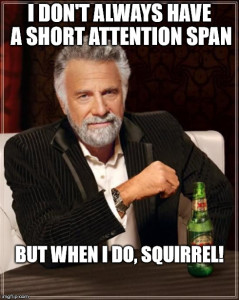By the end of that those few seconds, over half of a webpage’s visitors have left (according to research by digital metric tracker Chartbeat in 2014). And if you do a quick Google search on “how long do viewers stay on a webpage”, you’ll find a host of other stats, numbers, and figures, but they all point to a simple fact:
People don’t spend a lot of time reading online information.
This has important ramifications for your online presence, especially with your social media profiles. If you are using sites like LinkedIn to build your brand or a client pipeline, your profile acts as your personal business website. When a prospective client or other interested party visits, they are looking for more information on you, but they aren’t looking for an autobiography. You have only moments to communicate your message and engage them.
Think Like a Journalist – Focus on the Critical Message
It’s counter-intuitive, but to effectively snag your visitors in that window you have to realize that less can be more. Focus on short, powerful (and clear) messages instead of overwhelming them with a large amount of information. In this situation, quality is much more important that quantity.
That’s a challenge for most financial professionals, who are trained to be incredibly thorough when communicating with clients and potential clients. When diving into the complexities of financial planning, you can’t leave out information or overly simplify important facts. So it makes sense to cover everything online as well, right?
Not quite. It’s important to keep in mind that your online presence, especially your LinkedIn and other social media profiles, aren’t meant to be fully representative. They aren’t full sales conversations; in many ways they are your calling card. You aren’t trying to explain everything you to prospective clients. Rather you are offering an introduction so they choose whether or not to engage with you further (of course, be sure to include all of the relevant compliance information).
Short Attention Span does not Equal Stupid
 When talking about online attention spans with many financial professionals, I’ve encountered a dismissive attitude among many of them. They want to complain that the shorter attention spans of online visitors points to a lack of intelligence, sophistication, or decision-making ability. This is compounded when veteran financial professionals lump this together with complaints about the “younger generation”.
When talking about online attention spans with many financial professionals, I’ve encountered a dismissive attitude among many of them. They want to complain that the shorter attention spans of online visitors points to a lack of intelligence, sophistication, or decision-making ability. This is compounded when veteran financial professionals lump this together with complaints about the “younger generation”.
In reality, we live in a world with a glut of information, and we have to process it quickly. That goes for all generations. If you were a digital native who grew up in a world overloaded with information, wouldn’t you process information quickly as well? You’d want to make sure that you weren’t wasting your time.
Studies done by Microsoft also show that if someone does stay on a website for longer than 15 seconds, the likelihood that they’ll stay for a while increases. Basically, you have a few seconds to make a good first impression, and if you do make a good first impression and create value, people will give you more time. In this way, short attention spans are a way of vetting an information source to make sure it’s valuable and useful.
By the way, before we bemoan the short attention span of the next generation, keep in mind that it’s all relative. An ancient Greek who was listening to the Iliad (remember, they were an illiterate culture) would need more than a few seconds or minutes. It would take about 15 hours! So to them, we’ve been living “short attention span theater” for a long time.
Engaging the Short Attention Span Visitor on LinkedIn
While crafting your LinkedIn profile and other digital content, keep in mind the power of the first few seconds to grab or lose the attention of your visitors. Focus on making your message clear and to the point, so that you can help them justify spending more time with you.
Here are three specific strategies that can help on a Linked profile (that can easily be translated onto other sites):
1. Make the first 3 seconds count
The first exposure your visitors have to your profile will be your photo and your headline. It will take only moments for them to make judgments based on these few pieces of information. They won’t even do it consciously. Act like a journalist and create a strong lead. Look at your picture and ask yourself, “Does the person in this photo represent the message I want to send?” If not, find a new one. And does the headline (right under your name) clearly and succinctly tell your reader who you serve and how you help your clients.
2. Remove superfluous verbiage from your About and Current Experience
If you have only seconds to share your message, excess or vague information is a dealbreaker. When you copy/paste long paragraphs of marketing material from your company webpage, it takes your visitor too long to uncover the most relevant information. In fact, it’s likely that a visitor will see the info dump and simply skip it. Two to four short paragraphs with a few sentences are all that’s needed. Be clear, be concise, be succinct.
3. Keep the Previous Experience relevant to your target audience
When someone is visiting your profile, especially a prospective client or partner, they are not looking for your autobiography. They are trying to answer a question: should they work with you? Don’t upload your resume to LinkedIn, but rather explain your previous work in terms that are relevant to what you do today. Use that same litmus test for the other sections of the LinkedIn profile as well. Only include information that is relevant to your main message. For example, if you have authored articles that have appeared in financial planning publications, they should be listed. If wrote an article that appeared in a gardening magazine, leave it out. It’s not relevant and it muddies your message.
It’s too late to debate the positive and negative aspects of a short-attention span culture – it’s already here. If you are going to be successful in this new world, it’s important to position yourself in a way people can understand and digest. Remember, once you’ve engaged your online visitors, they’ve made an important decision to give you some of their attention (which is a very scarce resource). Then you can dive deeper into the complexities and nuances of how you help your clients. But don’t put the cart before the horse!

